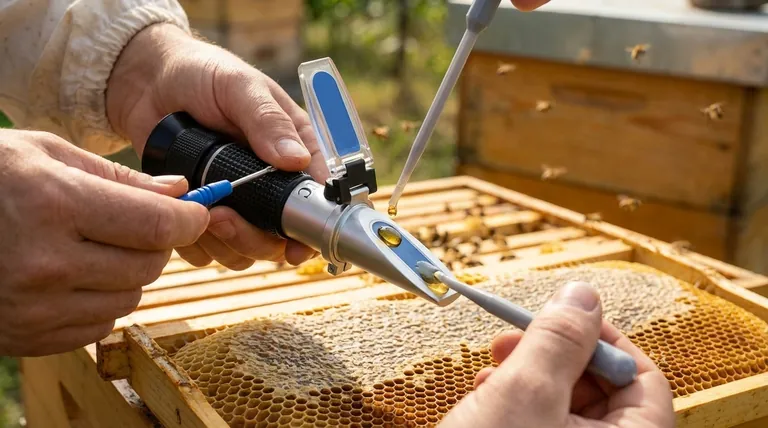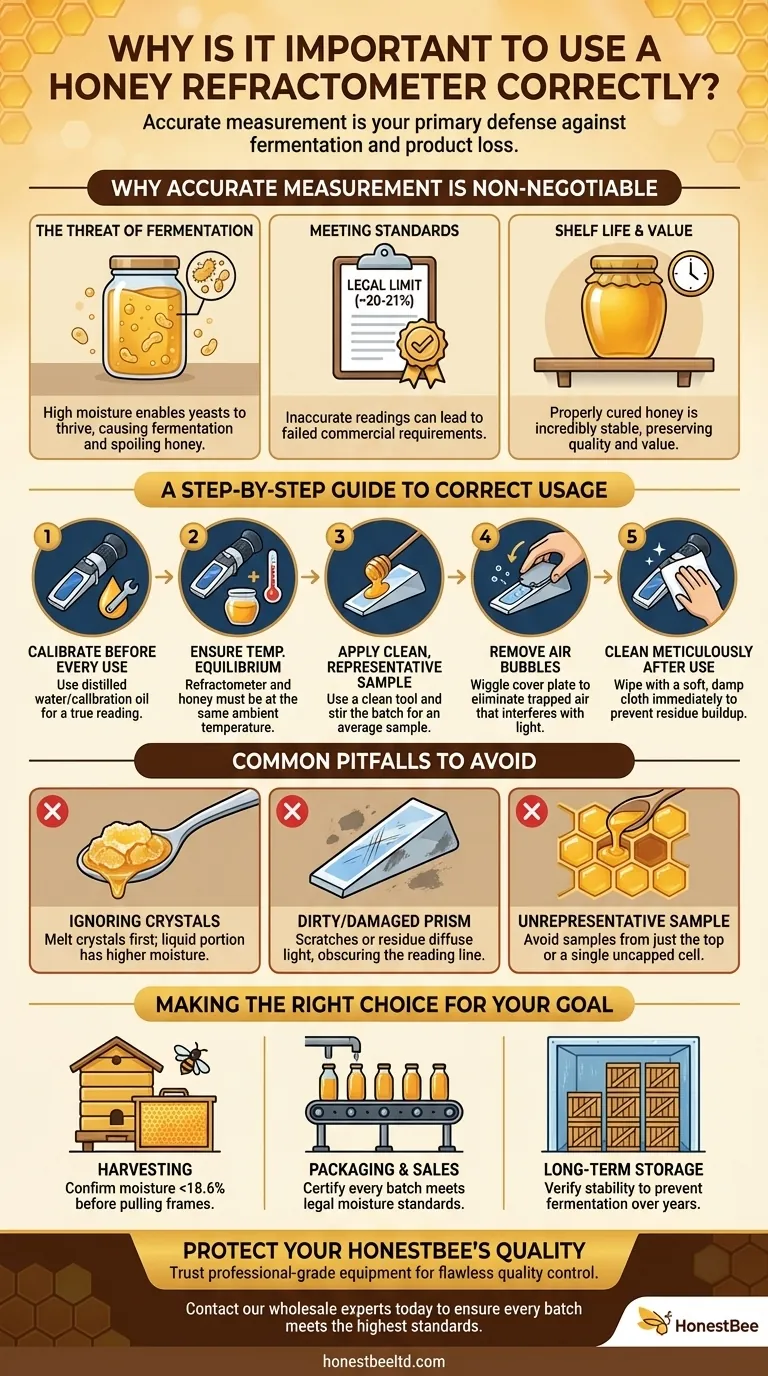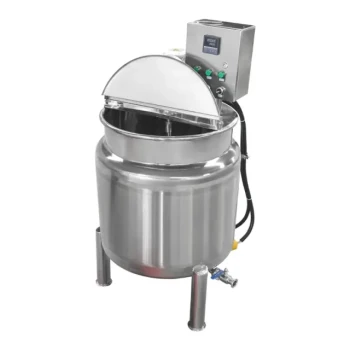Using a honey refractometer correctly is the single most important step in quality control for a beekeeper. It ensures your results are accurate and reliable, allowing you to confidently determine if honey is ready for harvest and safe for storage. Without proper use, you risk wasting an entire harvest due to fermentation.
The core issue is not just measurement, but risk management. Correctly using a refractometer is the primary defense against honey fermentation, ensuring the long-term stability, quality, and legal compliance of your final product.

Why Accurate Measurement is Non-Negotiable
A honey refractometer is a specialized instrument designed to measure the moisture content of honey. This single data point is a direct indicator of the honey's maturity and stability.
The Threat of Fermentation
Honey with a moisture content that is too high provides the perfect environment for naturally occurring yeasts to thrive.
These yeasts consume the sugars in the honey, producing alcohol and carbon dioxide. This process, known as fermentation, spoils the honey, giving it a sour taste and rendering it unusable.
Accurate readings tell you precisely when the bees have cured the honey to a safe moisture level, typically below 18.6%.
Meeting Quality and Legal Standards
For honey to be sold commercially, it often must meet specific legal requirements for moisture content. In many regions, this limit is around 20% or 21%.
An inaccurate reading might lead you to bottle honey that fails to meet this standard, putting your product and reputation at risk.
The Impact on Shelf Life and Value
Properly cured honey with low moisture content is incredibly stable and can last for years.
By verifying the moisture level with a properly used refractometer, you guarantee the quality and value of your product for long-term storage or sale.
A Step-by-Step Guide to Correct Usage
Following a precise procedure is essential for obtaining a trustworthy reading. Each step is designed to eliminate common sources of error.
Step 1: Calibrate Before Every Use
Calibration ensures your instrument is providing a true reading. This should be done before each testing session.
Most honey refractometers are calibrated using distilled water or a special calibration oil, which should give a known reading on the scale.
Step 2: Ensure Temperature Equilibrium
For the most accurate result, the refractometer and the honey sample should be at the same ambient temperature.
Significant temperature differences between the device and the honey can skew the measurement of how light bends, leading to an incorrect reading.
Step 3: Apply a Clean, Representative Sample
Use a clean tool, like a toothpick or hive tool, to place a small drop of honey on the glass prism.
Ensure the sample is representative of the batch. If testing from a large container, stir it first, as moisture can accumulate at the top.
Step 4: Remove Air Bubbles
Once you place the honey on the prism, gently close the cover plate. Wiggle the plate slightly to spread the honey evenly and eliminate any trapped air bubbles.
Air bubbles will interfere with the light path and cause a blurry or inaccurate boundary line in the eyepiece.
Step 5: Clean Meticulously After Use
Immediately after taking your reading, clean the prism and cover plate with a soft, damp cloth.
Dried honey residue can be difficult to remove and will compromise the accuracy of all future measurements.
Common Pitfalls to Avoid
Even with the right steps, small mistakes can lead to significant errors. Awareness of these pitfalls is key to maintaining accuracy.
Ignoring the Impact of Crystals
If your honey has started to crystallize, the liquid portion will have a higher moisture content than the solid crystals.
Testing crystallized honey without first gently warming and dissolving the crystals will give you a falsely high moisture reading.
Using a Dirty or Damaged Prism
Scratches, smudges, or old honey residue on the glass prism will diffuse the light, making it difficult to see a sharp, clear line for your reading.
Always inspect the prism for cleanliness and damage before applying your sample.
Testing an Unrepresentative Sample
Testing honey from only one uncapped cell or just from the top of a storage bucket can be misleading.
Always aim to get a sample that reflects the average moisture content of the entire frame or container you are evaluating.
Making the Right Choice for Your Goal
Correctly using your refractometer empowers you to make critical decisions at every stage of the honey production process.
- If your primary focus is harvesting: Use the refractometer to confirm that the moisture content is below 18.6% before pulling frames, guaranteeing the honey is fully cured.
- If your primary focus is packaging and sales: Use it to certify that every batch meets legal moisture standards, protecting your business and ensuring customer satisfaction.
- If your primary focus is long-term storage: Use it to verify the honey is stable and will not ferment, preserving the value of your hard work for years to come.
Ultimately, mastering your honey refractometer transforms it from a simple tool into your most powerful instrument for quality assurance.
Summary Table:
| Action | Purpose | Key Benefit |
|---|---|---|
| Calibrate Before Use | Ensure instrument accuracy | Reliable, trustworthy readings |
| Check Temperature | Match device and sample temp | Prevents skewed measurements |
| Apply Clean Sample | Use a representative honey drop | Accurate assessment of entire batch |
| Remove Air Bubbles | Eliminate light path interference | Clear, sharp reading line |
| Clean After Use | Prevent residue build-up | Maintains long-term instrument accuracy |
Protect your honey's quality and your business's reputation with professional-grade equipment from HONESTBEE.
As a trusted supplier to commercial apiaries and beekeeping equipment distributors, we provide the durable, precise honey refractometers and supplies you need for flawless quality control. Accurate moisture measurement is your first line of defense against fermentation and product loss.
Contact our wholesale experts today to discuss your apiary's needs and ensure every batch meets the highest standards.
Visual Guide

Related Products
- Precision Honey Refractometer Instrument for Quality Assessment
- 10L Stainless Steel Electric Honey Press Machine
- Stainless Steel Honey Press Wax Press with Tank
- Stainless Steel Manual Honey Press with Guard for Pressing Honey and Wax
- Electric Flatting and Embossing Machine with Tray for Beekeeping
People Also Ask
- What are the key steps to using a honey refractometer? Ensure Honey Quality & Prevent Fermentation
- What are the benefits of using a Pocket Digital Honey Refractometer? Achieve Precision & Speed in Honey Quality Control
- What is a honey refractometer? The Essential Tool for Perfect Honey Quality
- Why is a honey refractometer important for beekeepers? Ensure Quality and Prevent Fermentation
- Why is a honey refractometer considered essential for commercial beekeepers? Ensure Honey Quality and Profitability



















